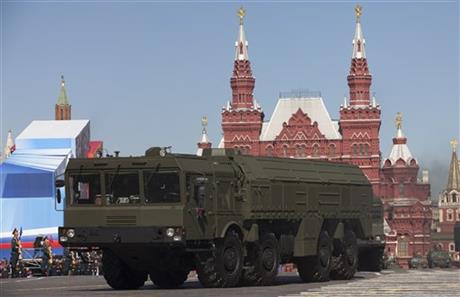
By VLADIMIR ISACHENKOV
FILE – In this Tuesday, May 7, 2013 file photo, Russian Iskander missiles make their way through Red Square during a rehearsal for the Victory Day military parade in Moscow, Russia. Russia’s Defense Ministry said Monday Dec. 16, 2013, that deployment of Iskander missiles in western part of the country doesn’t violate any international agreements. (AP Photo/Alexander Zemlianichenko, File)
MOSCOW (AP) — The deployment of short-range missiles in western Russia doesn’t violate any international agreements, the Defense Ministry said Monday.
The terse ministry statement, which was carried by Russian news agencies, came in response to the German daily Bild’s report that Russia has deployed the short-range Iskander missiles to its westernmost Kaliningrad exclave on the Baltic Sea. The territory — which borders the NATO and the EU member nations of Poland and Lithuania — is geographically separate from the rest of Russia.
The ministry spokesman, Igor Konashenkov, would not specify where the missiles have been stationed, saying only that “specific areas of the Iskander missile systems’ location in the Western Military District don’t violate any international agreements.” The Western Military District includes most provinces in western and northwestern Russia, including the Kaliningrad region.
Lithuania was quick to express concern.
“I am worried about signals that Russia is about to modernize missile systems it has deployed in Kaliningrad,” Lithuanian Defense Minister Juozas Olekas told reporters. “Further militarization of this region, bordering the Baltic states and NATO creates further anxiety, and we will be watching situation there closely.”
Russia has threatened for years to deploy the Iskander missiles, which are capable of carrying conventional or nuclear warheads, to the Kaliningrad region as a counterbalance to the U.S.-led NATO missile defense system. Moscow sees the missile shield as a threat to its nuclear deterrent.
The Iskander missile, which has a range of up to 500 kilometers (about 300 miles), travels at hypersonic speeds that make it very difficult to intercept and is capable of hitting targets with a precision of a few meters (yards). It was first used in action in Russia’s 2008 war with Georgia.
While the Defense Ministry stopped short of acknowledging the deployment of the Iskander missiles to the Kaliningrad region, the Kremlin-friendly daily Izvestia reported Monday that they have already been stationed in the area for more than a year.
Izvestia quoted Viktor Zavarzin, a deputy head of the defense committee in the lower house of Russian parliament, as saying the Iskander is needed to counterbalance NATO forces in Europe, including U.S. tactical nuclear weapons.
“We aren’t threatening anyone. These are defensive systems,” Zavarzin said, according to the newspaper.
Relations between Moscow and the West have been tense amid disputes over the U.S. missile shield, Russia’s human rights record and, most recently, Ukraine, where hundreds of thousands of demonstrators were protesting the Ukrainian president’s move to ditch a pact with the European Union in favor of closer ties with Russia.
—-
Liudas Dapkus in Vilnius, Lithuania, contributed to this report.



